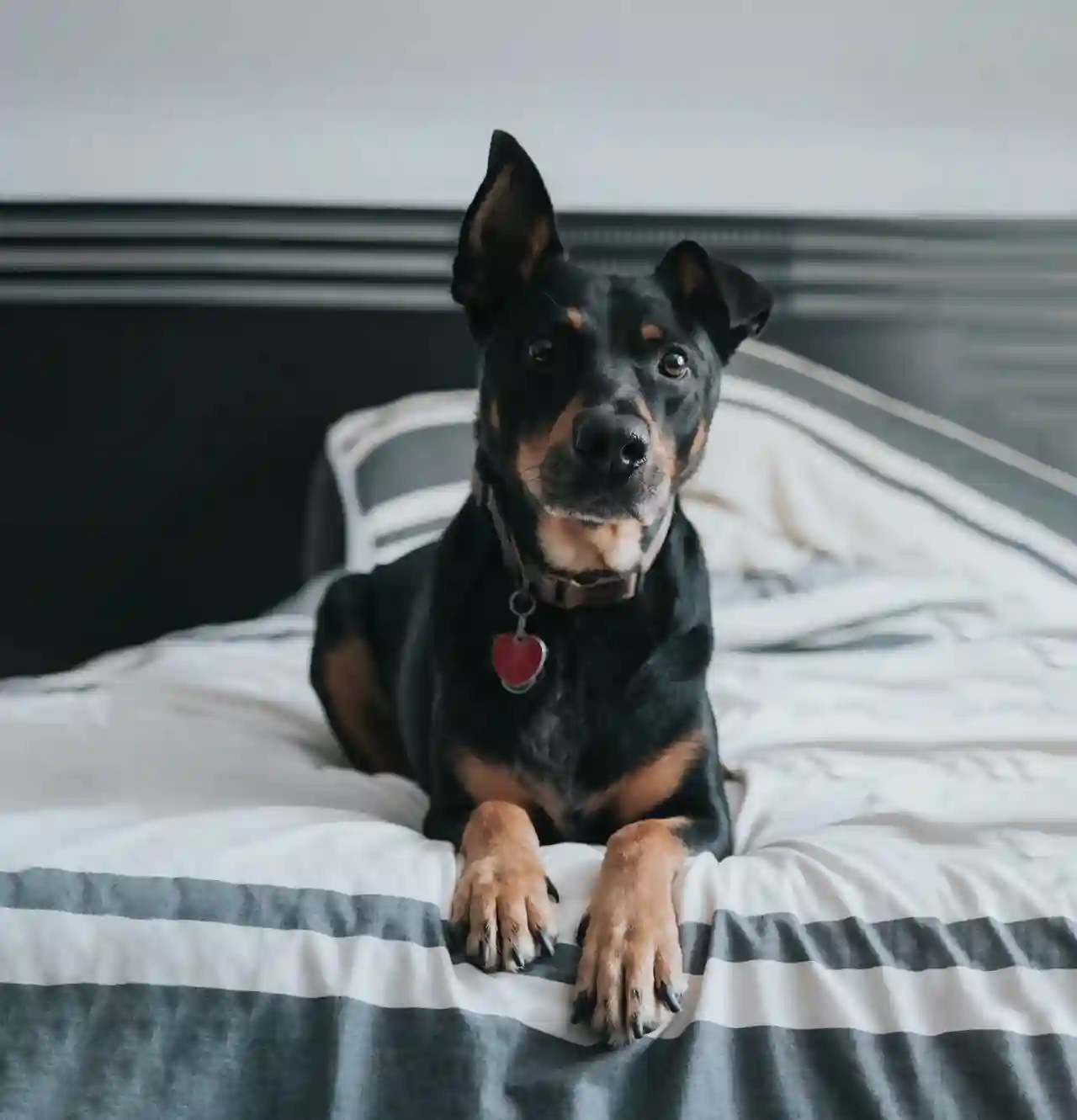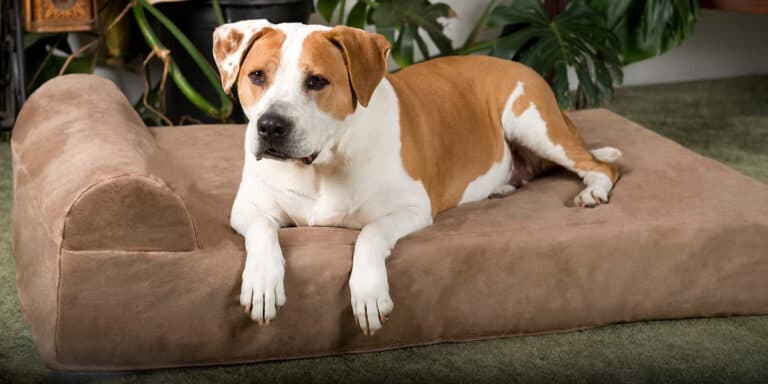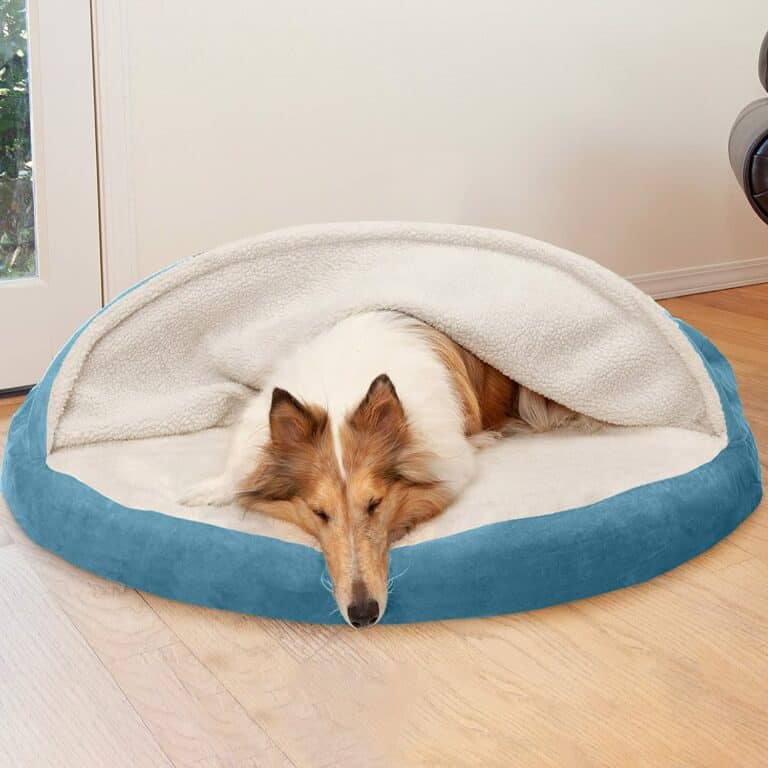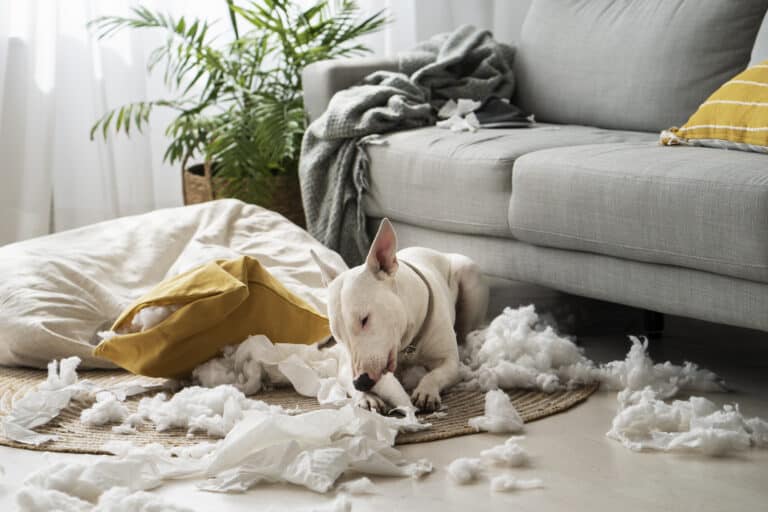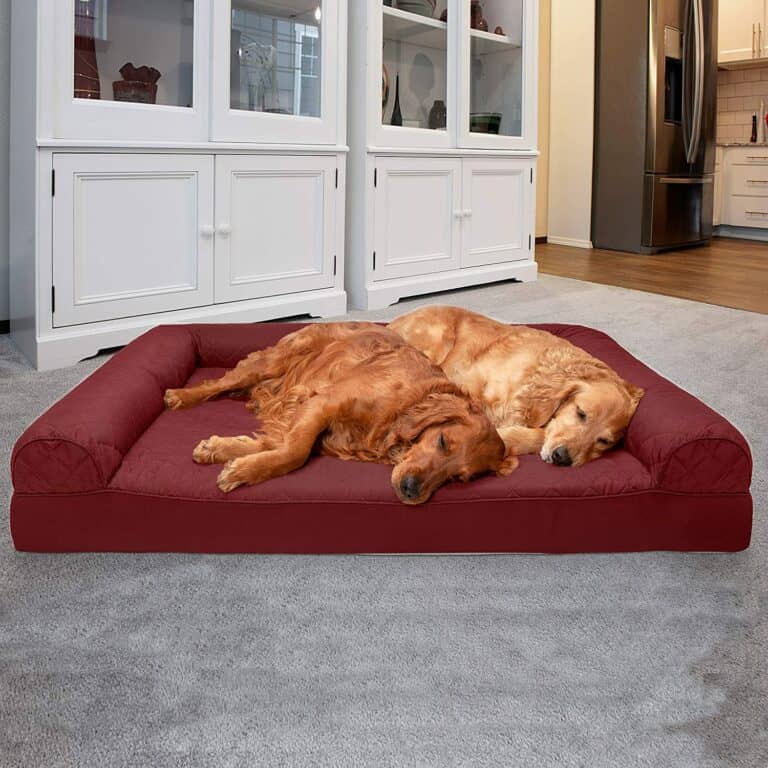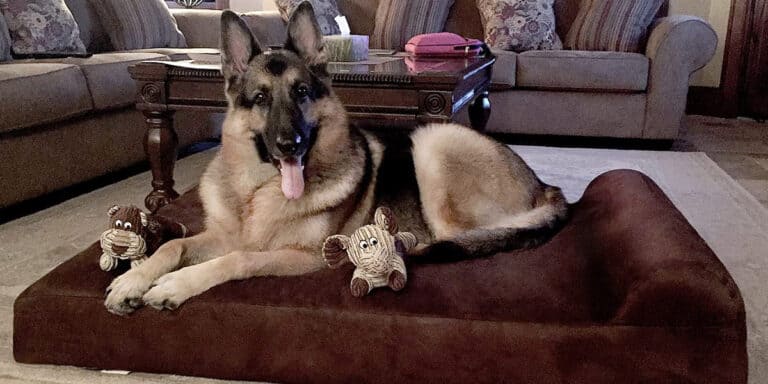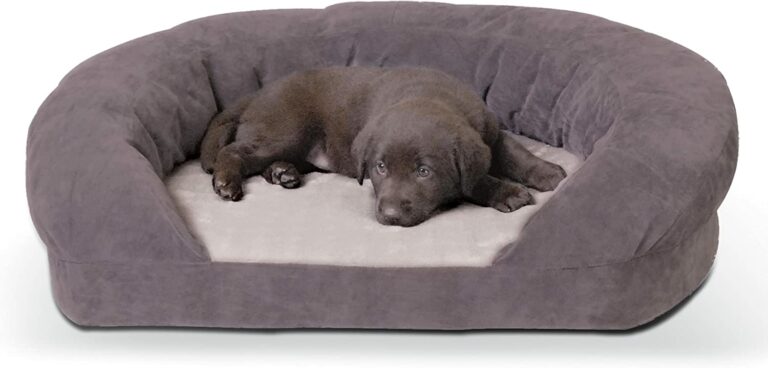12 Factors to consider while choosing the Best Dog Beds for Large Dogs
Dogs don’t ask for much. All they want is tons of love and a comfortable bed to sleep in. No wonder they are called man’s best friend. Which other human friend of yours wants nothing more from you than your love? Can’t think of many, can you?
If you love your dog to bits, as I do, you might be tempted to let him sleep in your bed with you. A lot of people feel that if their dog sleeps with them in the room it is beneficial to their sleep, and studies have actually found that the quality of people’s sleep increased when their dog is in the bedroom — however, that study also says that sleep quality decreased when the dog graduated from the floor to the bed.
A good compromise, in my mind, is to let your dog stay in your room, but instead of on your bed, get him his own!
A dog bed is a great investment to ensure that you and your dog are both getting a good night’s sleep. And unlike other dog treats and toys, a dog bed will last for many years if you maintain it well.
Let’s have a look at some of the best dog beds for large dogs in the market today and everything around them!
Do dogs need beds?
Strictly speaking, no it is not absolutely imperative that a dog must sleep on a bed. But then again, why not? If you say your dog is part of your family, then shouldn’t you treat him as one too? I’m sure all members of your family have their own beds. Why not your dog then?
For a dog, his bed is a place to call his own, somewhere he can slip off to when he wants to be just by himself, somewhere he can hide his goodies, or just someplace he is totally safe and not in anyone’s way.
Pros and Cons of a Dog Bed
Pros
- Comfort – A dog bed provides comfort to your dog, it is a warm, snuggly place of its own
- Boundaries – A dog bed helps teach boundaries to your dog by letting him know the areas he can or cannot go to
- Sound Sleep – A good dog bed will ensure better sleep – both for you and your dog
- No Calluses – A dog bed will prevent the formation of calluses that are caused when the dog’s body weight pushes directly through his bones and joints at the hip or the elbow when lies directly on the floor
- Bones and Joint Protection – A dog bed protects your dog’s spine and other bones from developing early arthritis or joint pain issues as it provides the correct support for your dog’s body
- Warmth – A dog bed keeps your dog warm and cozy and is good for not only his physical but also his mental health
- Preserves your Furniture – When your dog is lying comfortably in his own bed, he is less likely to chew away at the legs of your furniture.
- Preserves your floors – Likewise, your dog is less likely to scratch or litter your floor when he is safe in his own bed
- Easy Fur Cleanup – If your dog is the type who sheds a lot of hair, it’s better that he spends most of his time in his bed as it’s easier to collect all the hair from his bed rather than to clean the entire house.
- Easy Travel – If you want to travel with your dog, his bed can travel with him to provide familiarity – this is especially comforting to dogs who are anxious while traveling.
Cons
- Expensive – Some dog beds can be extremely expensive, but it’s not necessary that the most expensive beds are the best dog beds. Take your time to find the best dog bed for your furry friend because it will stand you in good stead for a very long time. Don’t look at it as an expense but as an investment in your dog’s physical and mental health.
- Hard to Clean – Sometimes dog beds are made of material that can stubbornly hang on to bad smells. They can also be difficult to clean fully and will hold on to stuff that has dried on the bedding.
- Easy to rip up – Dogs love to chew and dig and rip up their pillows and blankets – they seem to do it for every occasion – When they’re excited, when they’re nervous and when they’re scared. Every dog parent has experienced this for sure. Ask me!
- Refusal to sleep – Some dogs will just refuse to sleep in a bed. You may never figure out why they seem to fear the bed, they will never go near it and even bark at it. It’s so frustrating to buy an expensive bed and then have your dog refuse to have anything to do with it!
Where should dogs sleep at night?
Many dog parents are always in this dilemma – where should my dog sleep at night-time?
Even though adult dogs usually sleep about 12 to 14 hours a day, it’s important for them to have a good night’s sleep. When your dog spends so many hours a day on this one activity, don’t you think he deserves his own special space to sleep?
To find the perfect sleeping spot for your furry friend, it’s only right that you put in some thought and plan for it.
Dogs love soft and comfortable spaces to lie on. You may need to ask questions like
Take all this into consideration and decide on a dog bed after thinking about what is best for your dog, not just what is best for you.
Here are some of the places your adult dog can use for sleeping.
1. Crate
A crate provides a really comfortable space for your dog to sleep in! It is the best option when your dog is in his training period. A crate is also a good way to ensure that your dog doesn’t wander off into forbidden areas and cause trouble in the middle of the night. If you plan to train your dog in a crate, make sure to add comfortable padding in the form of blankets, pillows, or cushions, but not ones that he can chew up.

If your dog is the mischievous kind who loves to chew up everything, you should ensure that you stay away from pillows and cushions, because they have stuffing that can choke your dog, or create digestive problems, if he swallows it. The last thing you want is to take your dog to emergency surgery to remove all that stuffing.
Your crate should also be just the right size. It should be big enough to have enough space for him to stretch out comfortably, but it should also be small enough so your dog doesn’t use all that additional space to pee in the crate.
2. A basket or a bed
Giving your dog his own bed is one of the best things you can do for him. It is a place for him to call his own. However, make sure that the bed you buy is suitable for your dog in every way. The more comfortable your dog is, the less he will trouble you.

3. On your bed
One of the biggest debates dog parents have is whether to allow or not to allow their dogs to sleep on their beds. Like everything in life this too has its own pros and cons.
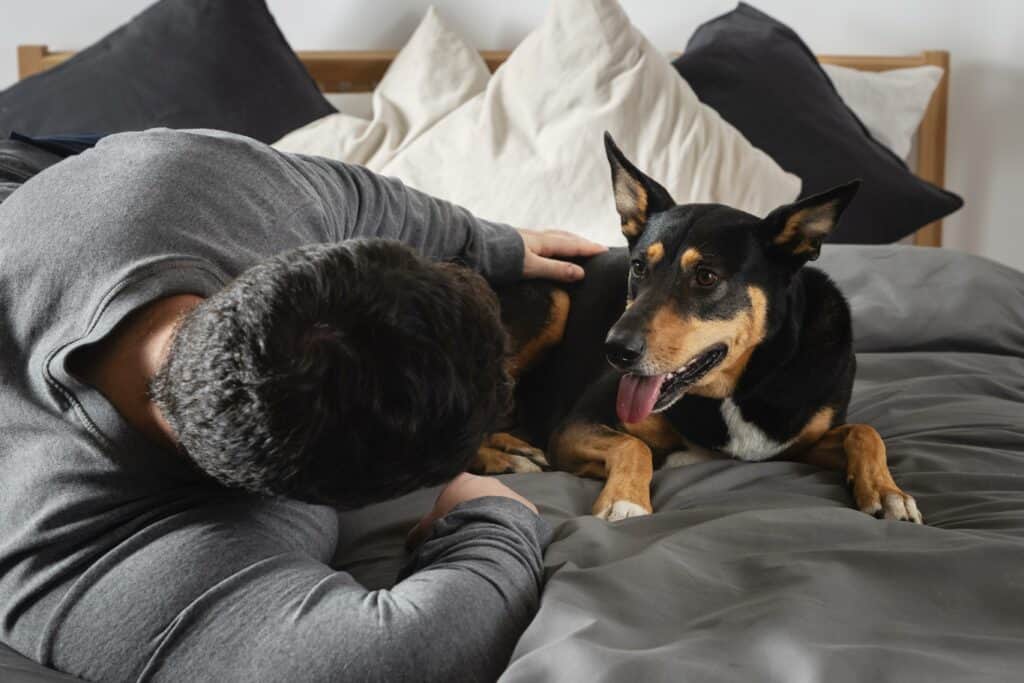
The biggest benefit is the bond that grows between you and your dog. There is a sense of comfort for both when there is a ball of warm fur lying on your feet all night. Co-sleeping with a dog is known to help the mental health of both the dog’s parents and the dog. People have been known to feel less anxious, depressed, and fearful by having their dogs sleep on the bed with them because it gives them a sense of security, warmth, and being wanted. Dogs make wonderful companions for people who are recovering from physical or mental difficulties.
On the downside, having a dog on your bed all night is going to cramp you up for space, especially as dogs are known to sprawl and stretch all over the space they have. Dogs who shed a lot of hair, or those who drool a lot, might also pose a hygiene problem. If your dog has allergies, he is going to pass on some of those germs on your bed too.
Whatever you decide, keep in mind that it is also what your dog wants and that it’s good for both of you.
Leaving the dog downstairs at night
When your dog develops a habit of automatically coming and sleeping with you upstairs, it’s time to train him to sleep downstairs. It will reduce his separation anxiety while you’re at work and also cut down on all that dog hair that collects upstairs. If this habit has been built over many years, changing it will take a little while. You will have to bribe him to keep him downstairs.
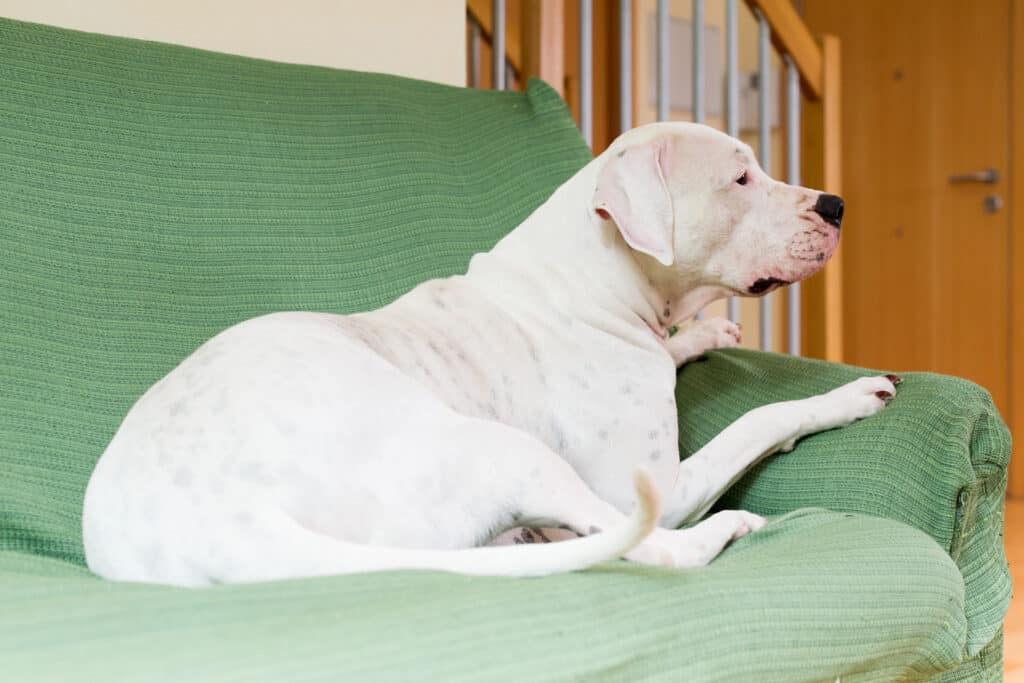
Often this process is as hard for the parent as it is for the dog. One of the best ways to wean him off coming upstairs is to find the perfect bed for him. Pad it with comfortable blankets and soft pillows, put his favorite toys into it, and soon he won’t want to leave his bed.
Create a positive routine around associating his downstairs bed with sleep time and reward him with his favorite treat when he stays in his bed at night. Surround his bed with the toys he loves, and he will be more willing to hang out there.
Sleeping Inside Vs Outside your house
Dogs are sensitive animals, and they always like to be as close as possible to their human owners. So don’t send them to sleep outside your house, that’s a cruel thing to do. Although dogs adapt themselves well to either cold or heat, they are not built to handle extreme conditions for long periods. If exposed to extreme temperatures for a long time, they will be vulnerable to ill health and sickness.

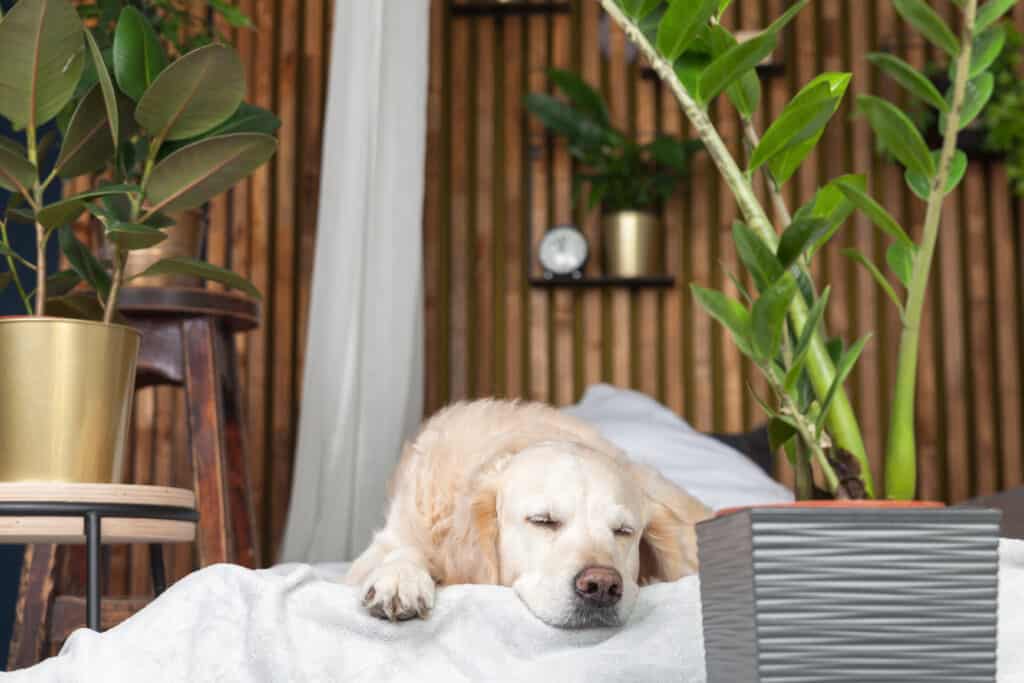
Inside vs Outside your room
People consider dogs as a part of the family and pamper them as much, if not more than their own kids sometimes. When one partner wants a dog sleeping on the bed and the other partner does not, a compromise can be made by having the dog sleep in the same room but in a crate or on its own bed. That works out best for all concerned. Your dog is not hogging all the space on the bed but it’s close enough for both of you to feel comfortable.
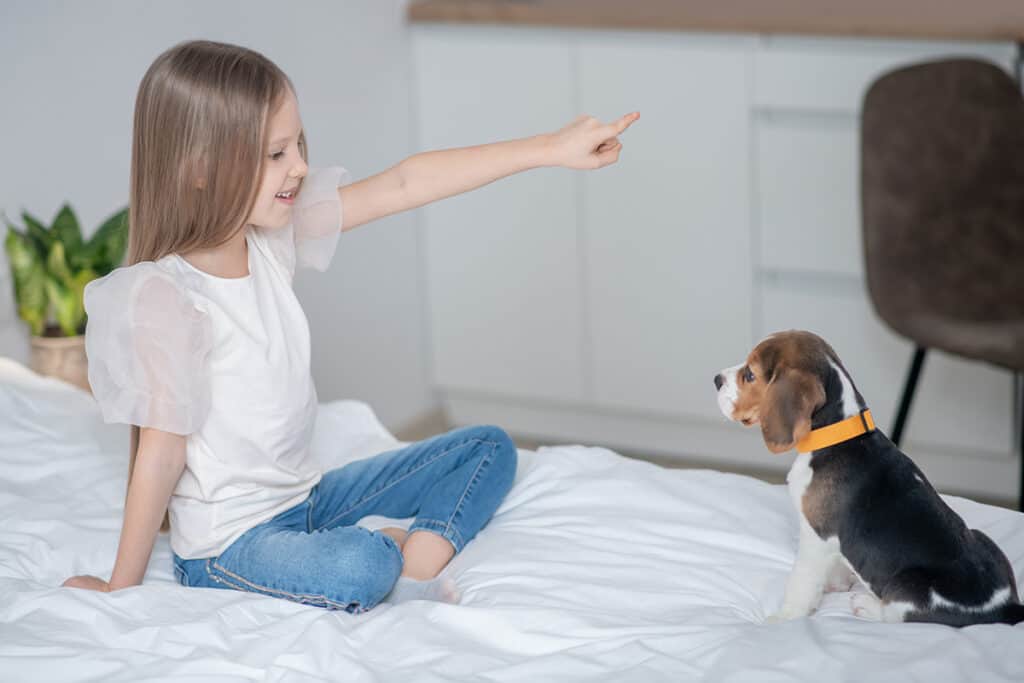
However, if your dog insists on climbing onto your bed several times in the night, even when you tell him firmly to go to his own bed, or if he disturbs your sleep by crying or making a lot of noise, then it is best to keep him out of your room. Again, that’s a personal choice each one must make, there’s no right or wrong here.
Sometimes it just takes a little bit of trial and error before you settle down into your rhythm. Also, it’s a good idea to let your dog choose his own space. Let him find his space and if you too are happy with it, then great, it’s all worked out for the best of everyone.
Crate vs Dog Bed for Sleeping
Crate
Pros
- A closed box-like place feels safe and cozy to your dog
- A crate can be easily moved around from one place to another
- Putting your dog in a crate will minimize accidents in your house
- When you are traveling, being in a familiar environment will make your dog less anxious
- A crate is very useful when you are potty training your dog – it will encourage your dog to wait to pee till he is let out since dogs don’t like to dirty the place they are sleeping in
Cons
- If your crate is too small your dog is going to be really uncomfortable and noisy
- If your crate is too big, there is a risk that he will pee in one corner
- Being confined in a small space will make your dog very nervous till the time he is properly crate trained
Dog Bed
Pros
- A dog bed is always comfortable and easy on a dog’s joints
- Even if he keeps shifting in his bed, he doesn’t make noise
- It’s a place to call his very own
Cons
- Even though he has a bed, he can roam around and cause trouble around the house
- If your dog is the chewy kind, he can drive you crazy chewing up the blankets and pillows, and will also cause himself harm doing so.
Finally, your dog should sleep wherever you both are sure of getting a good full night’s sleep. Whether he sleeps in a crate, a basket, his own bed, or on your bed, it should be what makes both of you happy.
What about Puppies? Where should a puppy sleep at night?
Just like a newborn baby, little puppies also make it equally difficult for you to sleep through the night. Lonely for their mother, and anxious because of a new environment, your new puppy can be very fidgety when you try to get him to sleep, waking up every so often. However, don’t fret too much, it’s not that difficult to get your new puppy to sleep peacefully through the night.
Just like humans, dogs too need a routine, so try to set down some rules for your little pup well before bedtime.
The best place to train your puppy is in a crate, even at night. You should make him familiar with the crate right through the day so that he gets used to it. Encourage him to play in his crate by making it a comfortable and cozy den, with soft blankets, pillows, and favorite toys. Reward him with treats when he obeys and stays in his crate.
At night place the crate near enough to your bed so that your dog can hear you and know that you are close by. Until he is potty trained, he might wake you up several times to go outside. Generally speaking, a puppy can control his bladder for the number of hours equal to his age in months plus one. So, if your puppy is 4 months old, he can go without urinating for 5 hours. That will give you a rule of thumb to plan how often you will get up during the night.
When is the puppy ready to sleep out of the crate?
Although these days, crates come in aesthetically good-looking designs, there probably will come a time when you don’t want them around. So how do you decide whether your puppy is ready to sleep out of his crate? You should ask yourself some of these questions before taking a decision
Although every puppy is different, normally they are ready to do the transition from a crate around the time they are 7 to 8 months old. And when you do make the transition, be sure to do it in a phased manner. Make it a fun activity for your puppy while at the same time making sure that your decision does not harm him or any other member of your family.
Why do dogs need beds?
The Importance of a Good Dog Bed
With dogs sleeping approximately 12 to 18 hours a day, and for puppies that go up to almost 20 hours a day, naturally, a good dog bed is so important to them. Don’t you like to have a comfortable chair in the office where you spend most of your day?
Even if they don’t spend the entire sleeping time in their bed, a good dog bed is important to your dog because it stands for a sense of security and personal belonging when they do sleep in it. It is also a place where they can relax without being disturbed, knowing that they won’t be removed from it.
It is pretty easy to clean a good dog bed without disfiguring or spoiling the bed. It doesn’t help to be stingy when it comes to buying your dog’s bed because you only land up being penny-wise and pound-foolish. If you buy a cheap bed, you may save initially, but your dog might pay the price with bad health, or you may end up buying a dog bed more frequently. If your dog loves chewing, he might chew up and swallow parts of his bed and run the risk of either choking on it or worse still might need surgery to remove what he has swallowed. Check out our article on What is the best Dog Bed for Chewers here.
A good and comfortable dog bed will also encourage your dog to spend more time in it keeping him away from trouble in other parts of your house.
Types of Dog Beds
Dog beds come in all shapes, sizes, and materials. You have the normal basic beds and then you have the special ones for dogs that are aging or have special medical needs.
A. Basic dog beds
1. Crate Mats
Crate mats are flat dog mattresses that fit inside the dog crates. They are usually inexpensive and easily available everywhere.

2. Flat dog beds
Flat dog beds are exactly that – flat mattresses often in a rectangular shape. These beds are great for dogs who like to sprawl out and stretch without anything coming in the way.

3. Sofa Dog Beds
Most dogs love climbing up and sitting next to you on your sofa even if you’ve trained them not to do so. You could instead get him his own little sofa dog bed. These beds are shaped just like little sofas and your dog will simply love them. This kind of dog bed is very stylish and comfortable and will suit dogs of any age and size.

Your dog will feel very special to have his own little sofa for himself especially if you have upholstered it to match your own sofa. This sofa bed will really last long and will be a source of great joy and comfort for years to come.
4. Nesting dog beds
Also called Snuggle Dog Beds, these beds are designed for doggies that love to cuddle and snuggle and burrow into blankets or bed covers.

5. Bolster dog beds
Bolster dog beds are the opposite of flat beds. They have bolsters on 3 sides of the bed which your dog can lie against. Dogs love lying down with their heads resting on bolsters.

6. Donut dog beds
The donut-style dog bed is one of the most typical beds available for dogs. As the name suggests, donut dog beds are circular-shaped beds, bolstered all around with a removable pillow in the center. They come in all sizes and colors and are not very expensive.

Also called round dog beds, these beds are ideal for dogs that like to curl up and sleep, as they are not really large enough for dogs that like to spread out and stretch out. However, if your dog is the one who likes to sprawl, and you are getting him a round bed, make sure that you buy a really large one so that he can sprawl out comfortably.
7. Cuddler dog beds
Cuddler dog beds have soft blankets attached to them to keep your puppy warm and cozy through the night. They are made from high-quality soft fluffy fur that keeps your dog never wanting to get out of it.

8. Cave dog beds
Cave dog beds are somewhat similar to nesting dog beds. These have a hood over half the bed, it could be rounded or tapered at the top like a cap or could be like a small tunnel if the hood covers the whole bed. This snug bed is great for your dog when he is in a playful mood and wants to hide from you.

The cave dog beds provide a cozy, warm, private space for your dog. Realistically these beds are more suited to smaller dogs. Unless you have a giant-sized cave bed your large dog will feel claustrophobic or smothered in it. Cave dog beds are also ideal for traveling with small dogs as your pet will feel safe and cocooned inside them.
9. Pillow Dog Beds
As the name suggests, these beds are just one pillow, it could be square, rectangle or round. They are basically just large cushions that your dog can rest on. These are ideal if you want a special place for your dog in every room, but do not want to put bulky dog beds everywhere. You could simply throw a pillow in the corner your dog loves to hang out in, and he will have his own special piece of furniture now.

10. Travel dog beds
What do you do when you want to take your dog everywhere, even when you’re traveling? Simple. Get a Travel Dog Bed. Whether it’s a simple run-around-the-corner to your favorite dog restaurant, or it’s a long bike ride into the sunset, or even a trekking expedition, you can take your best furry friend with you if you invest in a simple travel dog bed. Whether it’s just a travel dog mat or a travel dog bed for the car, you get them in all colors and sizes and allow you both to enjoy your travels in comfort!

11. Dog Cot beds
Also called an elevated dog bed, a dog cot bed keeps your dog elevated from the ground on a cot-like structure, thereby supporting his joints correctly by distributing the dog’s body weight evenly. The really large, elevated dog beds can be assembled and dismantled easily and quickly. Dog cot beds are useful when you want to have free-flowing air circulating all around your dog. They are not difficult to transport either.

12. Bean Bag dog beds
Bean bags make for great dog beds as your dog can bury himself into them, can dig and dig and find himself a cozy position before settling down for his slumber. Just make sure that your bean bag is made from durable, dustproof, non-toxic material and beans and that the safety zip is hidden safely out of his reach.

B. Special Dog Beds for Ageing Dogs or Dogs with Medical Problems
1. Memory Foam dog beds
These are good for older dogs who have started getting painful joints. The memory foam dog bed is made up of a good material that is soft and will distribute his weight evenly which will relieve pressure from your dog’s bones, giving him a stress-free night of sleep.

Memory foam gives just the right amount of support for your dog’s joints and muscles. These beds come in various sizes that you can choose depending on the size of your dog. These beds are suitable for dogs of any age.
2. Orthopedic beds
Orthopedic dog beds should be used if your dog has any medical issues with his bones or muscles and needs a high-quality bed to sleep on. This special bed has been made with your dog’s joint pains in mind and will give the right support to his old joints. These are also good for very large dogs as they are made from medical-grade foam and/or box-spring construction. Orthopedic dog beds usually come in two sizes, medium and large

3. Waterproof dog beds
Waterproof dog beds are an excellent option for dogs that have incontinence problems. These beds are also suitable when you want to put your dog’s bed outdoors.

4. Heated dog beds
Heated dog beds operate by generating heat on their own or by trapping the body heat of your dog for additional warmth. The most popular type of heated dog bed is the one that plugs into the electrical outlet which keeps it at one steady temperature. Some beds are fitted with a dual thermostat which regulates the required temperature and adjusts it accordingly by switching the thermostat on and off.

Homemade dog beds – can you make DIY dog beds yourself?
Yes of course you can. The easiest DIY dog bed is a pillow. You can simply cut out 2 huge pieces of rectangular fabric, stitch them up on 3 sides, then stuff them both with some old soft wool, fleece, or blankets and sew up the open parts. You can also use cotton canvas instead of cloth to make the pillow more durable. There are so many more ways to create DIY dog beds. Use some of these ideas to be creative and customize your dog’s own personal bed
What factors should you take into consideration while choosing a bed for your dog?
Here are 12 things to consider when you go looking for the best dog beds for large dogs
1. Your dog’s size
One of the most important criterion is the size of your dog. Don’t have either a very small one or a very big one. These are some general sizes according to the dog’s weight
Make sure that your dog fits entirely on the bed and that his head or legs are not hanging off the edge of the bed. Your dog should be comfortable in the bed whether he is curled up or he is stretched out.
2. Comfort
Like humans, dogs like to be comfortable when they sleep. So an important criterion should also be your dog’s comfort level. If your dog is not comfortable, believe me you’re not going to have a sound night’s sleep either.
3. Sleep position
You should choose your dog bed keeping in mind the position your dog uses to sleep in. How your dog sleeps will give you an insight into what kind of bed he will prefer. Common dog sleep positions include:
4. Supportive
Your dog’s bed should be able to support his joints and muscles and take the weight evenly.
5. Safety
Safety is of prime importance. Make sure that your bed can be placed in a safe place where nobody can trip over it. Make sure that your dog is not able to eat up pieces of your bed which can lead to him choking or having to undergo surgery to remove the pieces he has chewed up.
6. Stuffing
Use stuffing that works for you but first see what your dog needs. Foam stuffing is cheaper and might be okay for healthy young dogs, but as your dog grows older and/or develops joint problems, you need a filling that is of better quality and healthy for your dog.
7. Outer Cover
It is always better to have a dog bed that has a removable outer cover and an impermeable inner cover. Considering that dogs are not exactly known to be neat and tidy, being able to change the bed covers will ensure that the bed lasts long.
8. Easily washable
Dogs walk into all sorts of dirt and then climb into their beds. It’s important that your dog bed can be washed easily and frequently
9. Durability
The dog bed should be able to weather all the scratching, digging, clawing and chewing that your dog is going to do. That’s what dogs do. So, get a bed that is sturdy and durable.
10. Budget
The price will also be a concern to people with limited resources, but let money not be the only criterion in your choice of a dog bed. If you keep a healthy mix of money concerns and your dog’s health, you won’t go wrong.
11. Special needs
If your dog has special needs, it could be advancing age or ill health, or a recent accident, do make sure to take into consideration his special needs before buying his bed. For example, you may need to line the bed with absorbent pads if your dog wets the bed often. An older dog or a dog with joint problems might need an orthopedic bed.
12. Dog Preferences
Finally, also take a look at what your dog likes. Does he prefer
Best dog beds for large dogs
Now let us look at some of the best dog beds for large dogs that we have picked for you
Mistakes people make when buying a dog bed
Conclusion
I hope this article has convinced you that your dog does need a bed.
But not just any bed. You should take all the factors that concern you as well as your dog into consideration, weigh the pros and cons of all of them, and choose a bed for your furry friend after great deliberation.
There are so many brands of dog beds available in the market, of all shapes, sizes, and colors. Don’t get enamored by the first one you see and pick it up in a hurry. After all, your dog has to live with it for a long time.
Considering all our suggestions on the best dog beds for large dogs, I’m sure the love you have for your dog will guide you to make the best choice of dog bed for your furry best friend.
If you have any questions, do leave a comment below and thanks for taking the time to read this.

